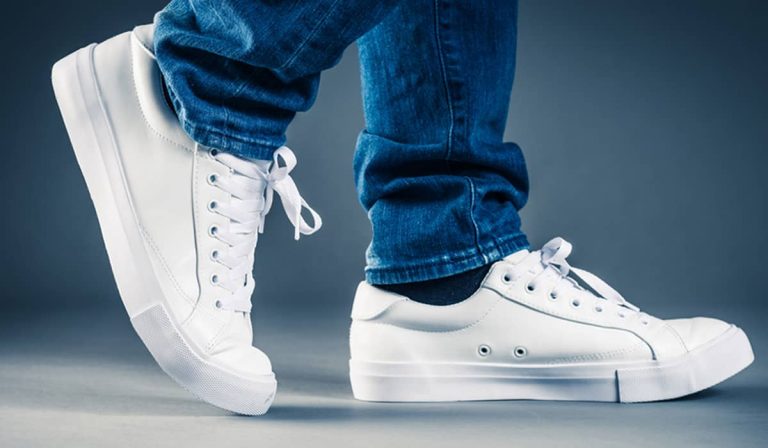How to Remove mold from Wood & Walls
Do you have mold on the wall or even on several walls? If you know the causes and signs of mold infestation, you can prevent mold and remove it in time. Read here what you need to pay attention to so that your apartment remains mold-free. Lets find out how to remove mold from wood and walls or any objects and how to prevent from mold.
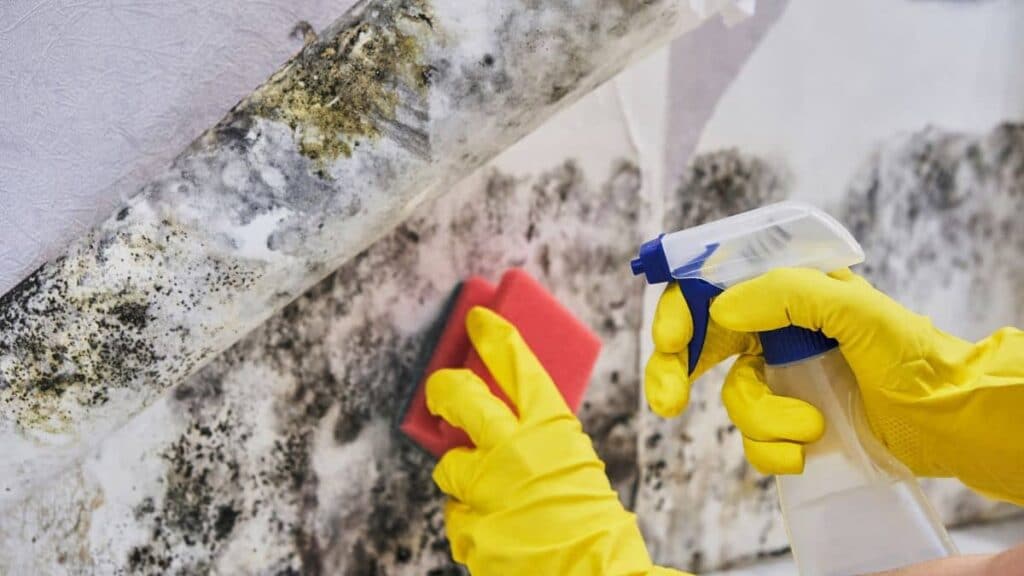
How to ventilate properly, you can read in our article Proper ventilation: Tips against mold in the apartment. Also important: Proper heating and mold in the bathroom: How to prevent and remove it.
How to remove mold?
Mold in the living space is harmful to the health and substance of the house. If you have discovered a mold infestation, it is important to find the cause and remove it. In this way, you can prevent mold from growing again. Work only with protective clothing in the fresh air with windows open and doors closed when removing mold. Use an FFP3 respirator to protect yourself from inhaling mold spores.
Before removing the wallpaper, paneling, or silicone grout from the affected areas, spray them with an anti-mold agent. By moistening, you prevent mold spores from becoming airborne. In case of severe mold infestation, we recommend stripping the affected plaster.
Then treat the surface thoroughly with a mold remover. After the application, the wall must dry completely. Make sure that the cause of the infestation is no more. Now you can re-plaster and wallpaper the wall.
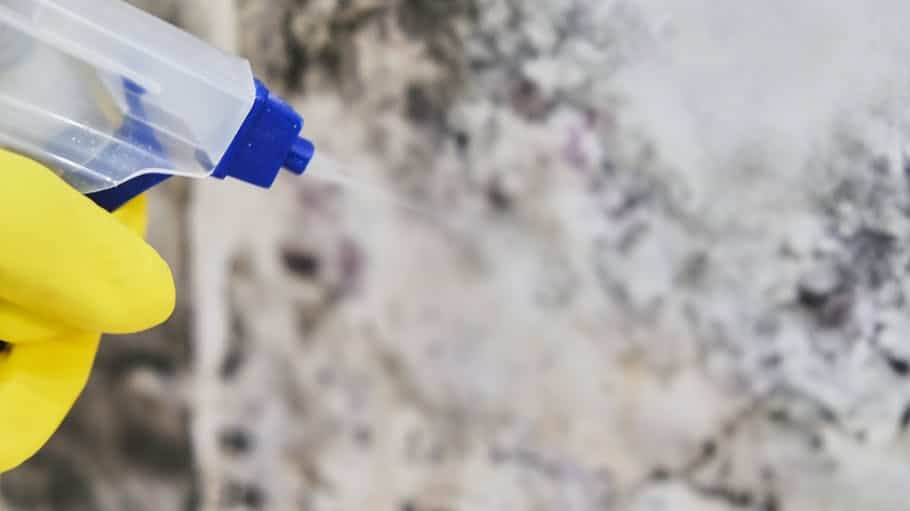
Note: A larger mold infestation, for example, in the basement or the house’s living room, you always remove with the help of a professional company. The experts will help you to identify the causes and take suitable remedial measures. Whether the infestation is large or small, only the complete elimination of the causes and the correct execution of mold remediation will permanently eliminate mold.
Can I remove the mold myself?
At some point, however, it is time to roll up your sleeves and remove the mold! Whether this is more or less involved, and you can do it yourself, depends on the extent of the damage and how the room you are using.
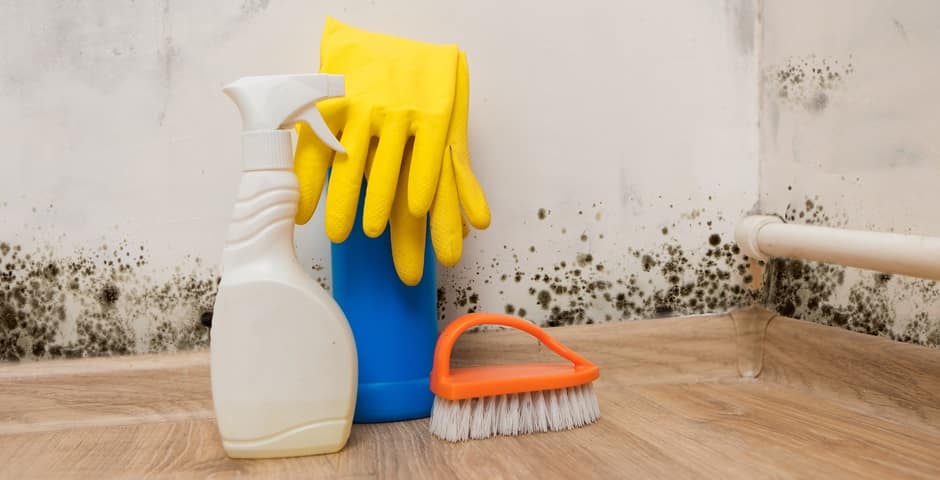
Ask yourself the following questions to find out if you can remove the mold yourself:
- How large is the infested area?
- Is it a single, superficial patch or a thick coating that extends into deeper layers?
- What type of mold is it? Some molds from toxic toxins
- Are materials that can be removed quickly or the masonry?
- Is there storage or living in the affected room? Do children or sick people live there?
But always bring an expert into the house because mold is not to be trifled with! Based on these criteria, the appointed expert will also assess your damage and derive the necessary protective measures for the remediation.
More extensive remediation work must and should always be carried out by professionals, who are familiar with the regulations to be observed! You can remove small places, only superficially affected mold areas yourself – provided you are healthy and have consulted your expert.
How to remove mold from wood?
The unpleasant mold spreads not only on walls, wallpaper, or joints but also on wood. Here you can find out how to get rid of the infestation.
As soon as you notice mold in your home, you should take immediate action to prevent it from spreading even further or mold spores in the air from irritating your respiratory tract. But how do you remove mold that has formed on wood?
Why does mold grow on wood?
You may wonder how mold can grow on wood. For one thing, wood soaks through moisture much more easily than other building components – and moisture is a big factor in mold growth. In addition, wood has high-quality nutrients for many types of mold, including cellulose. Combined with little air movement, we then have the perfect climate for mold growth on wood.
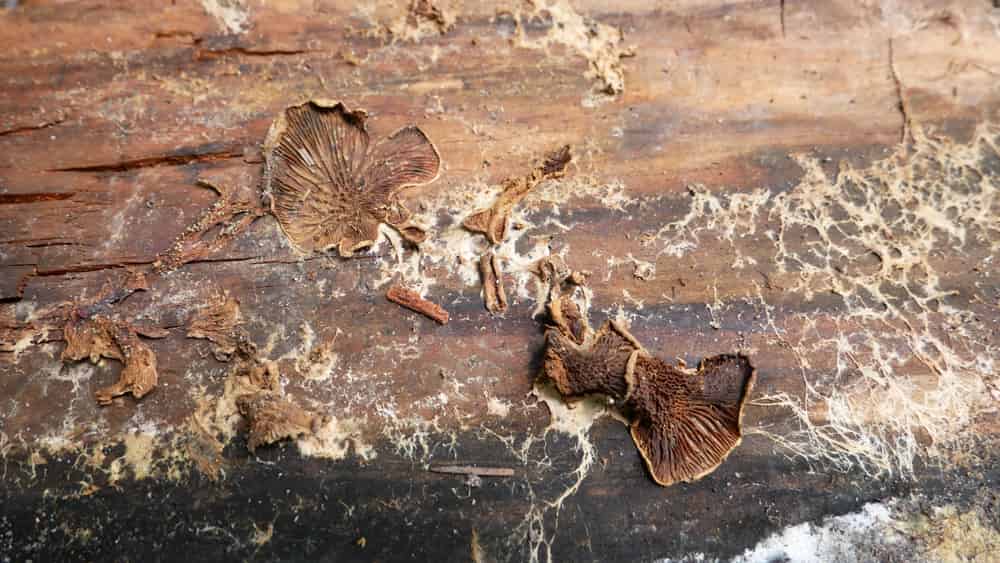
Where is it located?
Whether mold on wood is a major problem depends on where it is located. There are three possibilities:
- load-bearing wooden components
- non-load-bearing wooden components
- other wooden components, e.g., furniture.
If the mold* is on load-bearing structural members such as trusses or ceiling joists, you may need to check to see if it is still structurally sound. This is because certain types of mold can destroy the internal structure of wood. Mold on load-bearing members is usually caused by structural defects or if exposed to the weather. Usually, the risk of infestation is kept low because wood is only installed with a low residual moisture content of less than 20 percent.
If mold is present on non-load-bearing components, you should also be careful – after all, it can still spread to load-bearing parts. In any case, if mold is present on load-bearing and non-load-bearing components, you are best advised to consult with a professional who can take care of the problem.
You need to pay attention when removing mold.
You can usually do it yourself for smaller wooden components, i.e., primarily furniture or windows, as it is often a cosmetic problem. However, always wear protective goggles, gloves, and a mouth guard to prevent mold spores and chemical cleaners from irritating your respiratory system. Also, ventilate well so that the odor dissipates quickly.
Removing mold with chlorine-based cleaners and hydrogen peroxide
When mold spreads to visible parts of wooden furniture, it is usually a cosmetic problem, as discoloration occurs on the surface. You can usually get rid of this with chlorine-based cleaners or a hydrogen peroxide solution, as this will bleach out the stains. However, test the agents on an inconspicuous area beforehand to determine to what extent the surface changes color and leads to the desired result. In addition, you should always open the windows and protect your mouth and eyes from irritation when using such chemicals.
Removing mold from wood by sanding
For some furniture, it is also possible to sand off the mold as long as it has not penetrated too deeply into the wood and has not affected larger areas. Here, there is also the problem that the mold spores get into the air during sanding and thus infect other objects. So, in this case, it is best to consult an expert.
Removing mold from wood with methylated spirits – is that a good idea?
Methylated spirits are also a product that can be used to remove mold. However, you should not use it on wood – there is a risk that the material will become tired.
When it comes to mold removal, we always hear about vinegar as a remedy. However, the home remedy is often nowhere near as effective as thought. Vinegar is not necessarily suitable as a mold remover for porous surfaces such as textiles, wallpaper, or wooden furniture. At most, mold can simply be wiped off smooth surfaces with regular household cleaners – including vinegar or cleaning water with vinegar essence. This includes painted wood.
Preventing mold on wood
The best remedy for mold on wood is still prevention. If you follow these tips, you can reduce the risk by quite a bit:
- Keep surfaces made of wood dry, e.g., windows after showering.
- Make sure that furniture is made of varnished wood.
- Do not store wooden objects in a damp environment.
- Move wooden furniture away from walls – especially exterior walls.
- Prevent structural defects by providing adequate insulation, etc.
How to remove mold from walls?
Black mold is immediately noticeable on a white wall. But how do you remove the infestation without it returning? We have tips ready for you.
If you discover a mold infestation on your walls, you should not hesitate long and act immediately. After all, the spores are bad for your health and can trigger asthma, among other things.
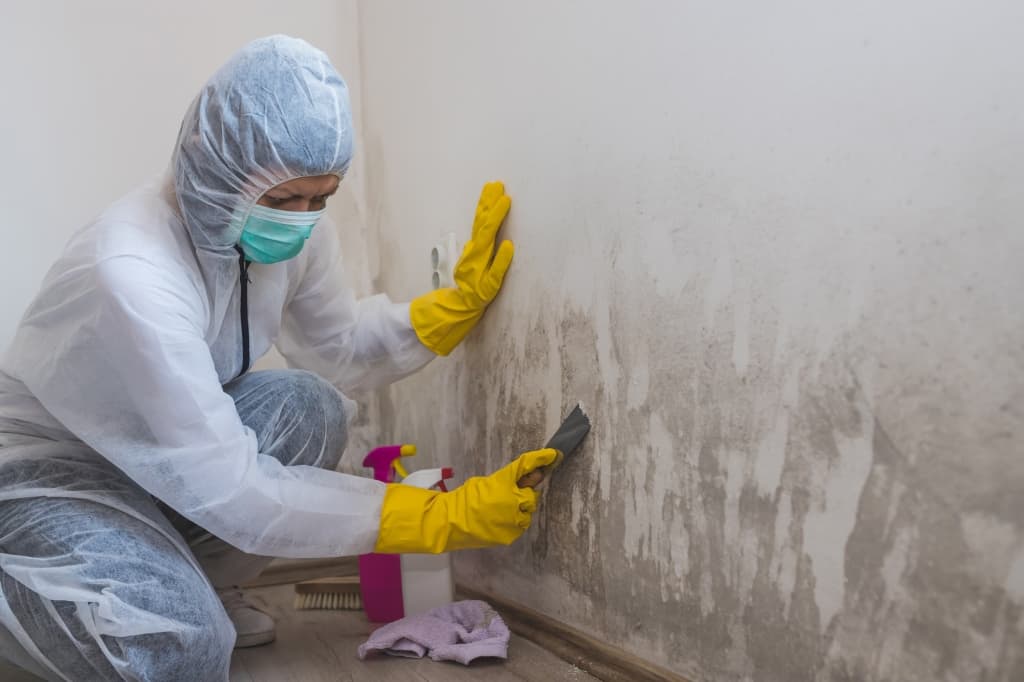
Why mold appear on the walls?
The fact that mold suddenly forms on the walls can have a variety of causes. These include:
- Structural defects
- The incorrect ratio between ventilation and heating
- Thermal bridges
Even if there are no structural defects – such as broken pipes in the walls – mold can form in any apartment. It always occurs when warm air meets a lot of moisture, settling on cold surfaces such as windows and exterior walls. Especially behind cabinets, where little air can circulate, the risk of mold is then quite high.
Removing mold: How to prepare for it
Since mold spores and mold removers can irritate your respiratory system, it’s important to protect yourself well: Wear protective gloves, goggles, and a mouth-guard whenever undertaking mold. Also, cover nearby furniture to prevent mold spores from settling on it. In general, you should always work with moisture when removing mold. If it is a larger mold infestation (more than 50 cm²), it is best to get a professional.
How to remove mold from smooth surfaces
The mold has settled on smooth surfaces such as tiles, ceramics, glass, metal, or tile joints? Then your chances of getting rid of the infestation are very high. Replace the wiping water several times and renew silicone joints in the bathroom if they are particularly badly affected – otherwise, the mold will always return.
Removing mold from porous areas with alcohol
However, mold often appears on plastered or painted walls. The best remedy here is 70 to 80 percent ethyl alcohol (ethanol). Apply this with a cloth or rag and then ventilate well. Also, be careful that no fire comes near it – otherwise, there is a risk of fire.
Removing mold with hydrogen peroxide
If the mold has formed in insensitive places, hydrogen peroxide can also help you remove it. Hydrogen peroxide is typically used in medicine as a disinfectant or bleach. However, a three-percent solution from the pharmacy will also remove mold from your walls, as it will also disinfect and bleach these areas. So be careful which surfaces you use it on – you may need to repaint later. You brush the hydrogen peroxide itself on and around the affected area in a large radius. After about an hour, wipe it off with a damp cloth and let the area dry. All the time, you should ventilate well.
Methylated spirits against mold on the wall
You can Methylated spirits on a smooth and porous surfaces. To do this, drip it on a cloth and wipe the affected areas with it.
Here, too, however, there is a risk of fire and explosion. Therefore, you should apply only gradually small doses and in no case smoke nearby.
Remove mold from the furniture.
Chairs or cabinets with closed surfaces can be cleaned with a damp cloth, dried, and disinfected with 70 to 80 percent ethyl alcohol. Please wear respiratory protection and apply the alcohol with a cloth, and do not spray. There is a risk of fire and explosion! Upholstered furniture such as armchairs or sofas is usually very difficult to clean properly. Disposal is often cheaper.
Removing mold from wallpaper and silicone joints
The best way to remove mold from wallpaper and silicone joints is to replace them. If they are only superficially affected, they can be wiped with a damp cloth or vacuumed with a vacuum cleaner with a fine dust filter (HEPA filter) and then disinfected with 70 to 80 percent ethyl alcohol. Be sure to observe the previously mentioned protective measures!
How do you remove mold from any objects?
If a small area, for example, on a wall, is affected by mold and the cause is not serious structural defects, you can remove mold remediation yourself. Before you start removing the mold, open the windows of the affected room and close all doors to other areas. We recommend that you properly dispose of all infested furniture, carpets, and other items. This way, mold spores will not spread to other areas of the house or apartment.
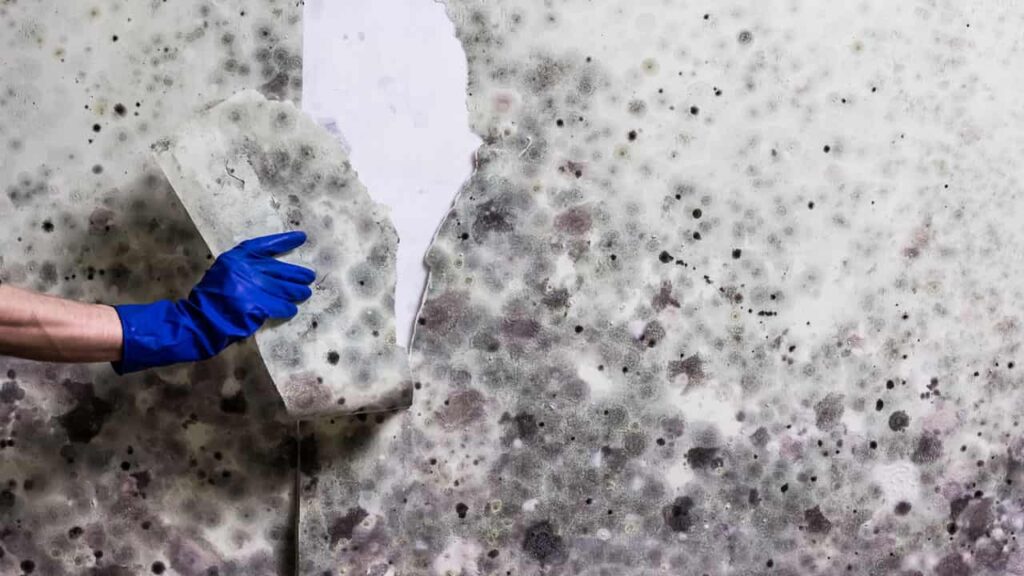
Move furniture or home accessories out of the way while you work. Protect them from contamination with masking film. Wear appropriate protective clothing during mold remediation. We recommend at least gloves, a breathing mask, and protective goggles. Note: After work, remember to wash your clothes and your body thoroughly.
To ensure fewer mold spores become airborne:
- Spray the area of mold infestation carefully.
- Do not dry the area.
- Remove the affected wallpaper.
Odorless and chlorine-free mold removers are suitable for the kitchen, bedrooms, and children’s rooms. In the bathroom and shower, you can use chlorine-based products. Always follow the manufacturer’s instructions and adhere to them for your own protection and to avoid damaging surfaces. Chlorine-based products have a bleaching and disinfecting effect.
An alternative home remedy for dry surfaces is 70 percent ethyl alcohol (ethanol) and 80 percent ethyl alcohol for wet surfaces. However, there is an increased risk of fire and explosion when using it. Therefore, we generally recommend the use of anti-mold agents instead of household remedies such as alcohol or vinegar.
Carefully remove the affected wallpaper and dispose of it immediately. Do the same with old silicone in joints. For remediation, we recommend using anti-fungal sanitary silicone or mold-blocking silicone—thoroughly clean tiles with an anti-mold agent.
Remove the affected plaster around the mold infestation over a large area. To completely remove the mold, thoroughly clean the area around the infestation after the work. The infested material can be disposed of in the household garbage if you pack it safely in garbage bags.
If the wall of the house is damp, a standing fan will help it dry. For smaller areas, you may be able to use a hairdryer or hot air gun. However, caution should be exercised when doing so because of increased fire hazards.
Home remedies against mold
When removing mold, it is necessary to wear protective clothing and open the windows. Essential here are gloves, goggles and a respiratory mask marked P2. Only then wipe the infested areas several times with a soaked cloth or sponge. After that, they must be disposed of in a bag in the household waste. And with this, you can soak the rag:
- 70-percent alcohol: If the mold infestation is small and superficial, consumers can fight it themselves. 70-percent alcohol – also known as medicinal alcohol – is particularly suitable for this purpose.
- Hydrogen peroxide or methylated spirits: Another mold killer is hydrogen peroxide. Cleaners containing chlorine should be avoided because the vapors can cause irritation of the mucous membranes. Methylated spirits also help.
- Vinegar for metal and ceramics: Vinegar can also be used to combat mold. However, the antibacterial effect is only successful on metal or ceramics.
Does the home remedy help against mold on the wall?
In many places, people are advised to use vinegar or vinegar essence to get rid of the mold problem. This may also be true for certain materials, but the Federal Environment Agency advises against using vinegar as an aid, at least with regard to diffusion-open building materials.
In the event of a possible chemical reaction with building materials, the pH value could be raised, and an additional nutrient substrate applied to the affected areas. Thus, you are promoting mold growth rather than containing it.
How to prevent mold?
Check humidity
Check the humidity in your house or apartment regularly and especially in suspected cases with a hygrometer. With the hygrometer, you determine the relative humidity in the rooms. In the long term, this should be between 55 and 60 % in living areas and somewhat lower in winter. Too low humidity has a negative effect on human health. A higher humidity supports the formation of mold.
Heating the apartment and house properly
In addition to humidity, room temperature is also important. You heat living areas such as children’s rooms, dining rooms, and living rooms, i.e., rooms in which occupants are actively present, to around 20 °C. This is the ideal temperature for a home. For other living areas, such as the bedroom and kitchen, and during absences, around 17 to 18° C is recommended. At night, these temperatures can again be at least 5° C lower. These are the figures recommended by the Environment Agency. When heating, it is important to avoid thermal bridges between rooms or materials. Otherwise, condensation can form, which in turn supports mold growth. Therefore, close doors between rooms that you heat differently. If the rooms are well insulated, you can heat the entire living space to the same temperature.
Ventilate properly
Correct heating and humidity control also include correct ventilation. Only through proper ventilation will excess humidity be transported out of the living space. Instead of tilting windows for long periods of time, carry out shock ventilation for five to ten minutes several times a day. This is particularly important in the bedroom, bathroom, and kitchen. If ventilation is not possible on a regular basis or for structural reasons, use a dehumidifier. In the kitchen, again, a powerful extractor hood helps to reduce humidity.
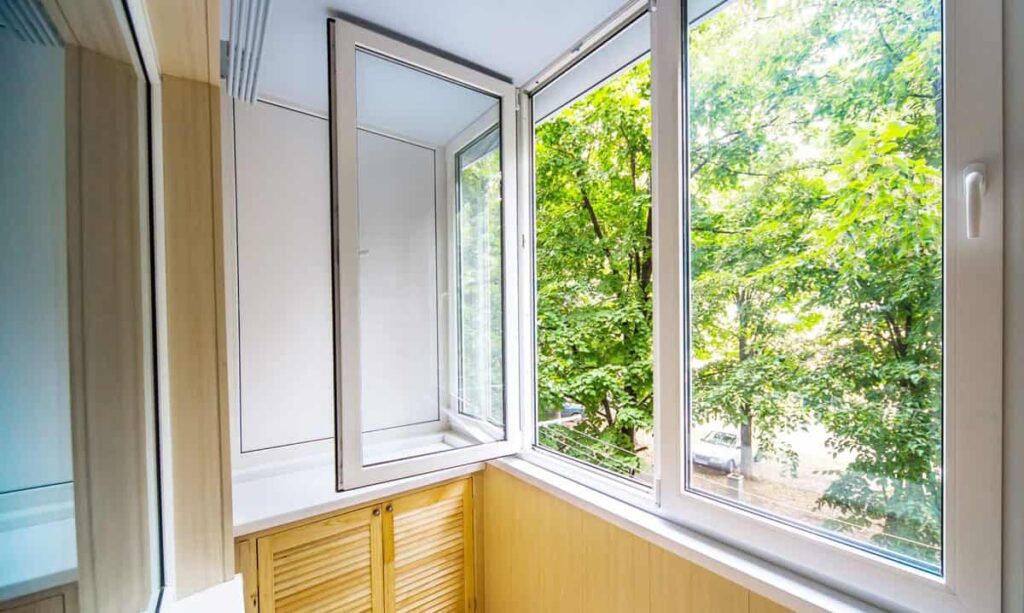
In the bathroom, we recommend that you ventilate particularly carefully. Dry the shower, bathtub, and, if necessary, the floors after each use and hang towels up to dry immediately. Generally, do not dry your laundry in rooms that already have higher humidity. In bathrooms without windows, the regulation of moisture is of particular importance. For example, use the suitable bathroom or room ventilators.
Further measures
Do not place furniture or similar items directly in front of cold exterior walls. Keep a distance of 5 to 10 cm from the outside wall to allow air to circulate freely in the room. Keep radiators clear and insulate their backs against exterior walls. You can treat problematic walls in your house or apartment with anti-mold impregnation or paint them with anti-mold paint. However, you should always tackle the causes in your house or apartment first to give mold any chance.
After mold removal or remediation
Removing the mold alone is not enough. You must find out the cause of mold growth and remove theme as soon as possible. Otherwise, the game starts all over again. Common causes of mold in the home and on the wall are: Poor sealing of walls, increased moisture production in the interior (e.g., due to plants, drying laundry, or shower wetness), incorrect ventilation, or insufficient heating.
Avoid mold in the apartment.
You should remove mold from the apartment immediately, because it can make you sick and damage the building. With a few simple measures can prevent the emergence of mold.
Mold develops wherever there is too much moisture. The causes are manifold. The main reasons are:
- incorrect insulation
- leaks or cracks in roofs, masonry, and windows
- incorrect heating and ventilation
- condensation of humidity on cold walls
In old buildings, mold often occurs when exterior walls do not have sufficient thermal insulation but have new, well-sealing windows. In new buildings or after construction, mold can form if you do not dry out the rooms properly.
Close the bathroom door after showering
After showering, the bathroom door should remain closed. Otherwise, the water vapor will spread throughout the apartment. It is better to check the shaft ventilation in the windowless bathroom regularly. Each room should also be heated and ventilated individually. And place the bed in the bedroom in a little distance from an outside wall for better air circulation.
Tips and warnings to avoid mold.
- For the renewal of mold-infested areas, if moisture is comes again, you should use inorganic materials. These include lime plaster and lime-mineral paint coats (silicate interior paint), which are usually more expensive than the usual binder paint, but more vapor permeable and inorganic.
- If possible, do not stick wallpaper to the critical wall areas, as these usually form new breeding grounds for mold spores. With some types of molds, connections to diseases of the lungs and allergic diseases are suspected since the spores can get onto the skin and into the respiratory tract through the air.
As a rule of thumb, if the area of mold growth is larger than a credit card, remove them by a professional company. If prompt removal of the mold is not possible in this way, the further spread it can prevent by spraying the affected areas with hairspray. The mold spores are encapsulated in this way. Small areas, for example, in the bathroom on joints, silicone seals, or window reveals, you can remove them also by yourself.
Various cleaning agents are commercially available to combat surface mold. An old household remedy for mold removal is vinegar essence. However, caution is advise here: Molds can metabolize the acetate contained in vinegar, so vinegar forms an additional source of nutrients for mold and allows it to continue growing.
Most mold removers are based on the active ingredient benzalkonium chloride, a strong disinfectant. It destroys the cell walls of the fungi. However, benzalkonium chloride can irritate the skin and cause severe allergies – just like chlorine, the most aggressive active ingredient in the fight against mold. High-percentage isopropyl alcohol is less irritating. The odor also dissipates more quickly than chlorine, so that you can use the room again immediately after intensive airing.
Wear protective clothing
In principle, the following applies to all mold removal measures: Do not touch the mold, do not inhale spores, or let them get into your eyes. Therefore, if possible, wear gloves, protective goggles, and a respirator mask with FFP3 marking when working. Clean up thoroughly after mold removal.
Causes of mold growth
A common cause of mold in the home is improper ventilation and heating. Mold thrives when humidity is high, and house walls are cold and damp. Damage to water pipes as well as construction defects also promotes mold growth. A defective roof or cracks in the masonry can be just as responsible for mold as a burst pipe or rising dampness in the basement. To ensure that moisture can escape from floors and walls again, always observe the correct drying time of the building materials during construction work. If the house is not correctly insulated, thermal bridges can develop between different components and areas. This may cause moisture and condensation to form, which in turn can promote mold.
If there is water damage in the living room, the furniture and sofa will be underwater.
Signs of mold infestation
The first signs of mold are often a musty smell and stains on walls, joints, furniture, carpets, or other objects. In addition to the black mold that often appears in the house, there are also white, green and yellow, as well as red mold growth.
Different types of molds
Black mold
This type occurs when there are moisture problems throughout the house. Black spots often grow and then areas will be different from dry to slimy due to many different types of molds. Black mold is seriously harmful to your health.
White mold
White mold can appear in unheated, cool, and damp areas such as the basement. It is not always easy to spot, especially on white surfaces. Then other signs will help: A musty smell, as well as the frequent occurrence of woodlice and silverfish, are indications of a possible mold infestation. White mold is consider a risk factor for various diseases. Affected people often complain of symptoms similar to dry indoor air. Also, this can lead to incorrect diagnoses and counterproductive room humidification.
Green mold
Green mold occurs in the home on food, plant soil, and in damp areas and joints. The fungus often forms a furry, fluffy coating. Green mold can cause allergies and asthma, for example, but is considered less harmful compared to other types.
Yellow mold
Yellow mold is rather rare in this country. However, it can occur mainly in the case of poor hygiene. It prefers damp corners, upholstery, or cotton fabrics. Yellow mold, like black mold, is particularly harmful to human and animal health.
Red mold
Red mold can form on cellulose-containing surfaces such as paper wallpaper. It prefers a moist environment such as the bathroom. Red mold is less harmful to health than black or yellow mold but can cause asthma.
You can also read this posts: How to clean White Shoes
